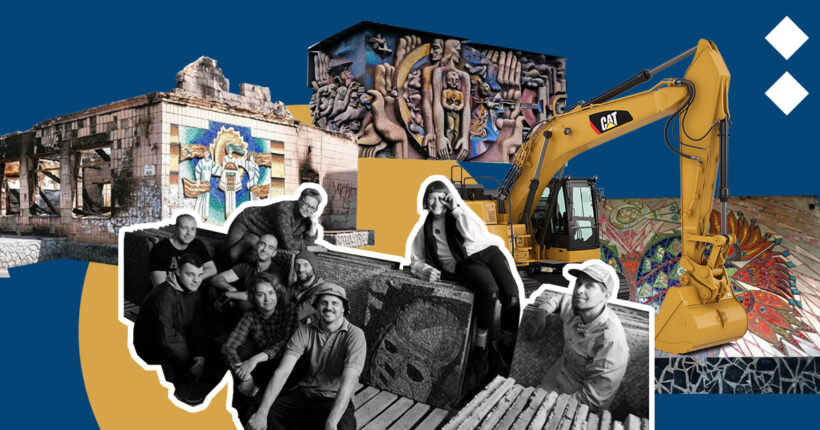
What is the problem?
Ukrainian mosaics from the Soviet era are being dismantled and destroyed by Russia's occupation and military forces in Ukrainian cities and villages. At the same time, Ukrainians also do it because a part of the society perceives these sights as a bitter reminder of Soviet propaganda. Most such monuments do not have a protected status, so they are also destroyed in local construction and renovation projects.
For example, the invading Russian army destroyed the Tree of Life and Boryviter mosaics in Mariupol, which were created by Ukrainian artist Alla Horska and others. In Sievierodonetsk, the massive panels of the Ice Palace were reduced to rubble. Chernihiv's airport was almost completely destroyed in March 2022, and mosaic panels of the famous artist Volodymyr Zinchenko along with it.
Stained-glass windows and decorative panels which embellished the 1950s-era buildings in Nova Kakhovka were flooded after the destruction of the Kakhovka Reservoir by Russian occupying forces.
In Makariv, in the Kyiv region, a beautiful public mosaic depicting Ukraine's generous people and fertile land – which had already survived the town's occupation and bombardment – was destroyed by a local Ukrainian man – just one of many such examples in recent years.
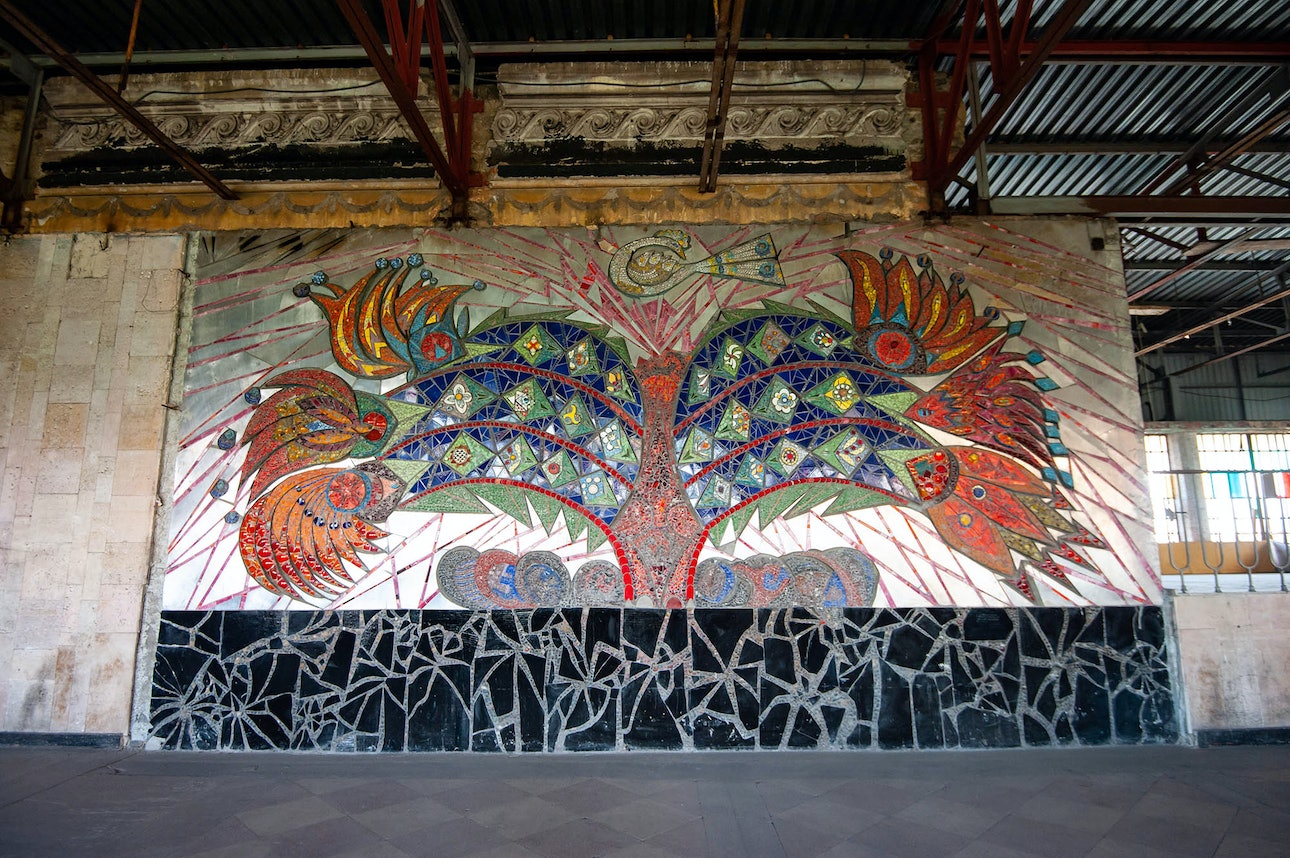
The Tree of Life mosaic by Alla Horska and Viktor Zaretskyi. Source: birdinflight.com
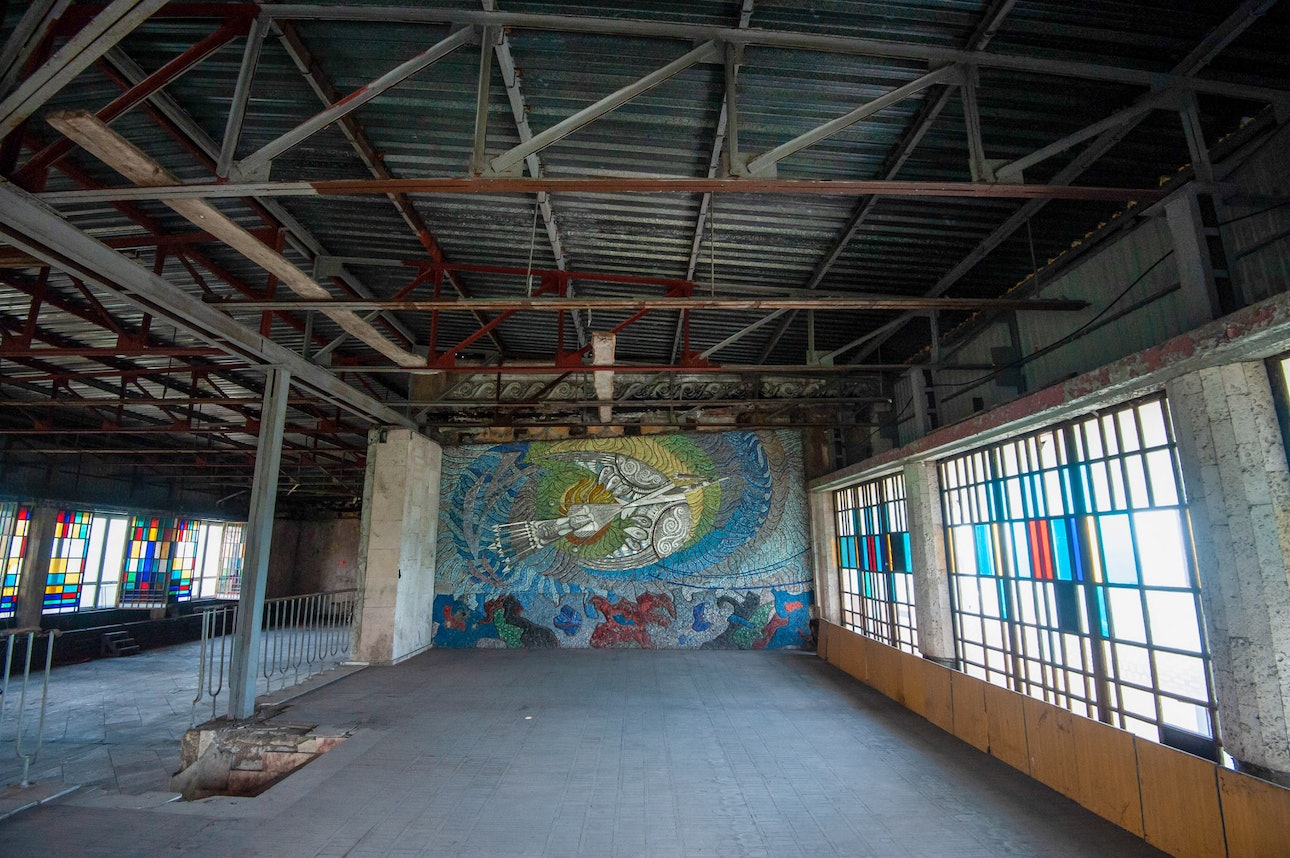
Boryviter mosaic by Alla Horska and Viktor Zaretskyi. Source: birdinflight.com
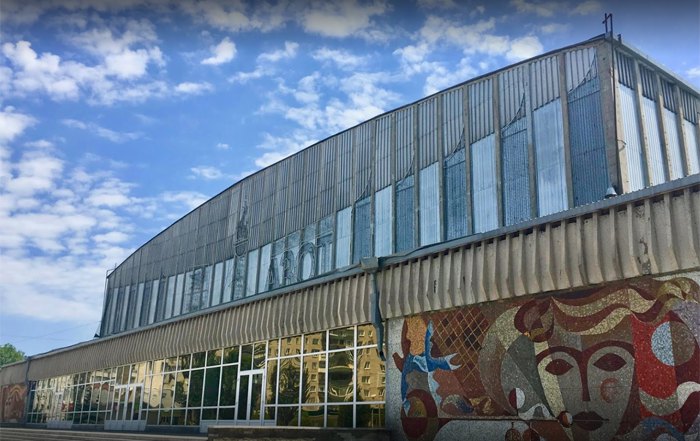
The Ice Palace in Sievierodonetsk. Source: hromadske.radio
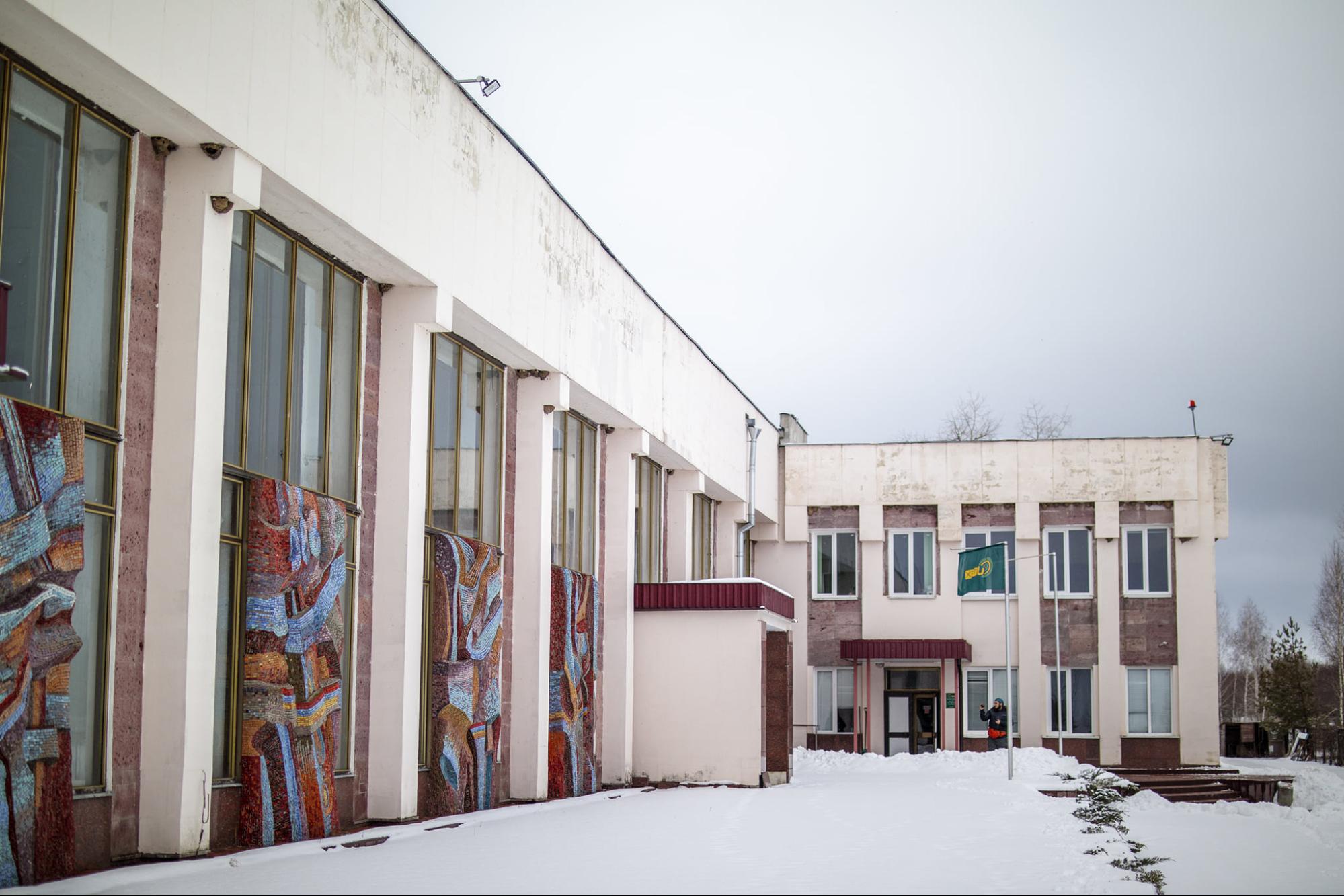
Chernihiv Shestovytsia airport with mosaics by Volodymyr Zinchenko. Source: Chernihiv Monumentalism Facebook page
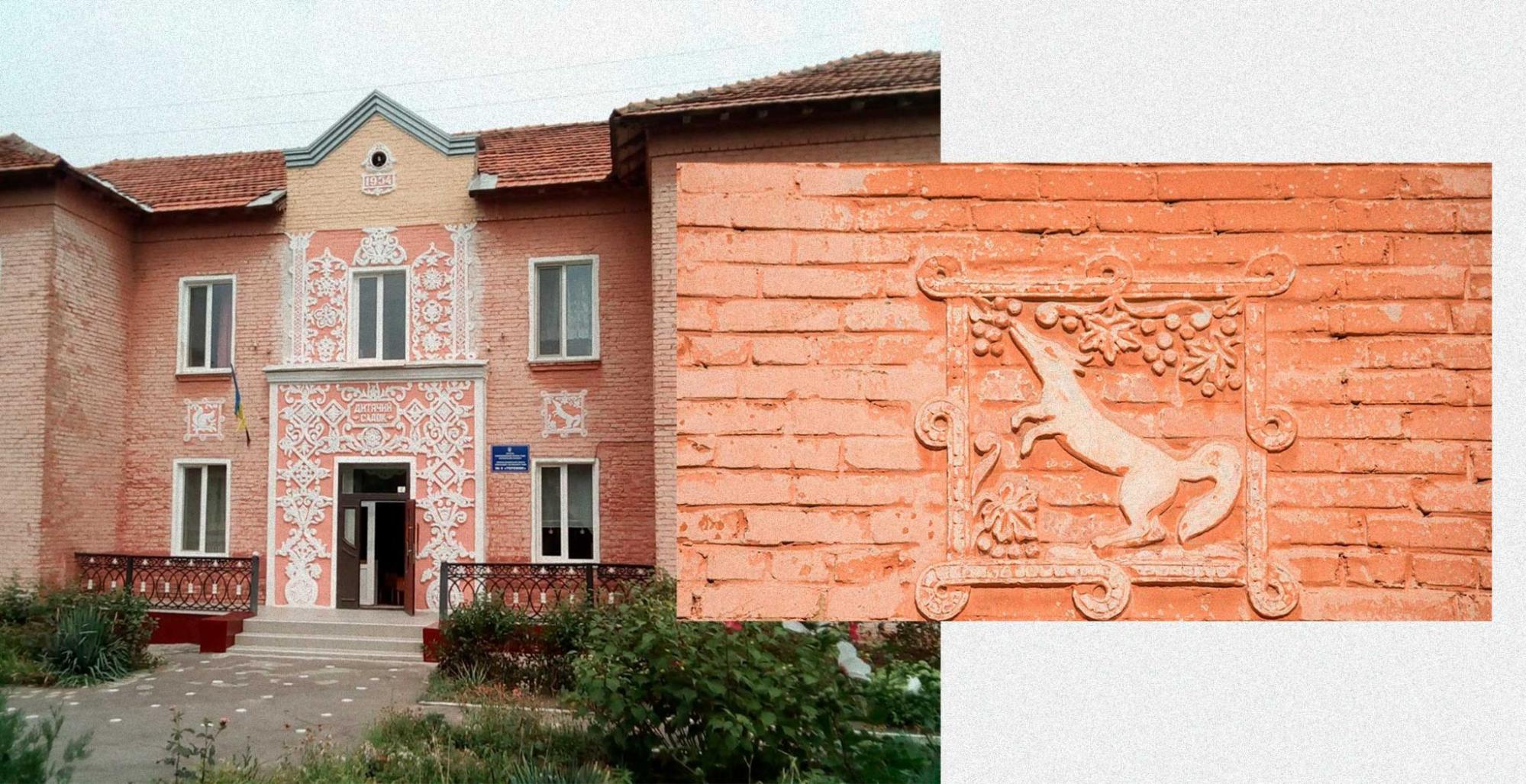
Ornamental panels in Nova Kakhovka. Source: mayak.org.ua
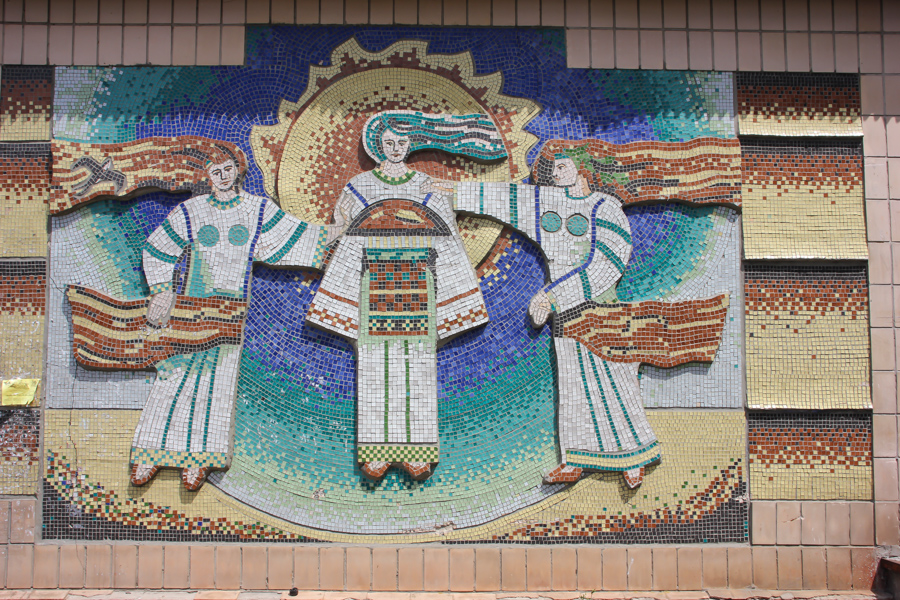
Mosaic at a shop in Makariv. Source: nin-gen.livejournal.com
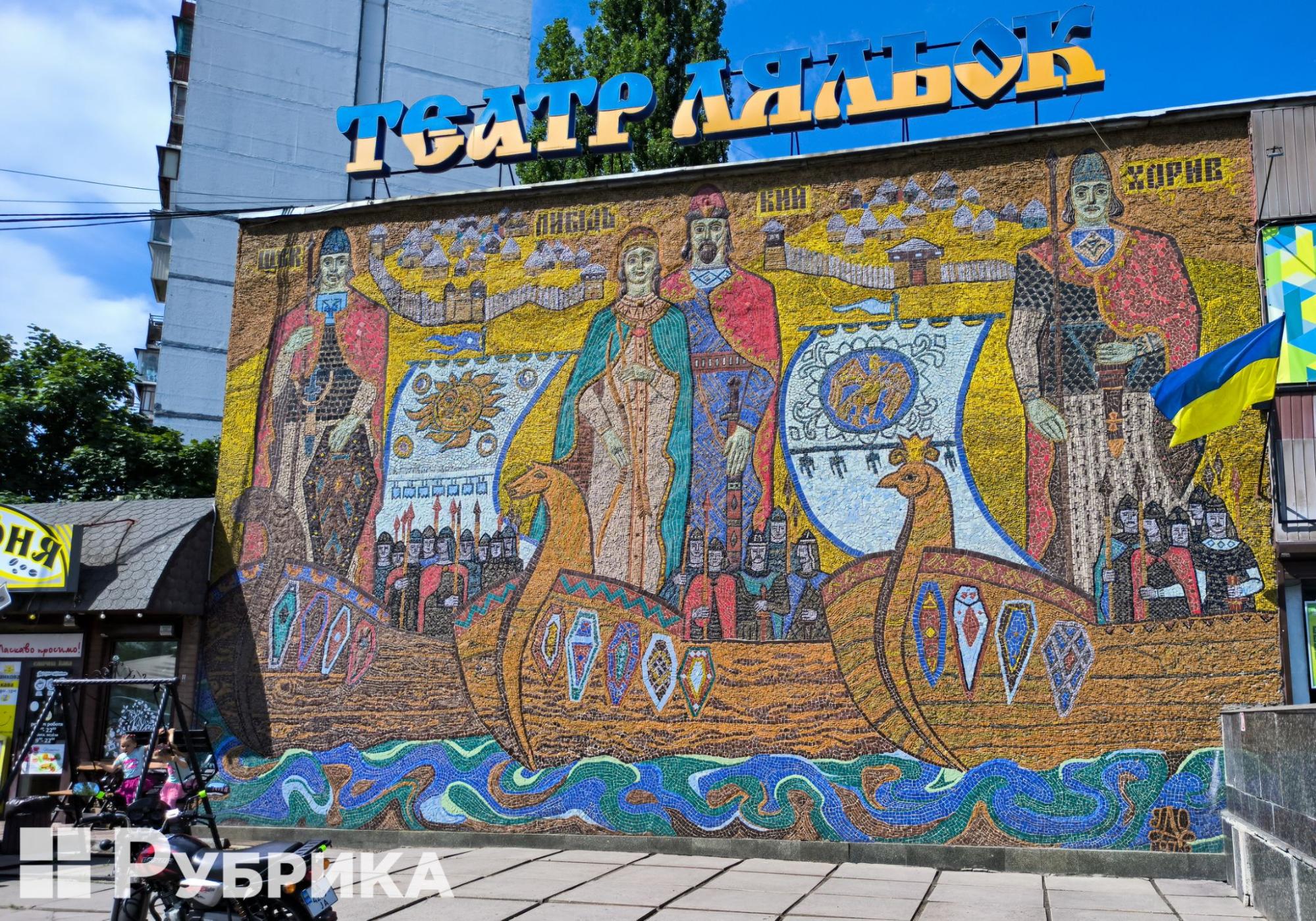
A panel on the wall of the former Play cafe is now the Kyiv Municipal Academic Puppet Theater on the left bank of the Dnipro. Photo: Mykola Tymchenko
Why did it happen?
While many would like to forget the era of Soviet colonization, when Ukraine's unique national identity was suppressed and appropriated for propaganda purposes – art that was made by Ukrainians should still be preserved, according to art critic Yevhenia Molyar. Those who tear down Soviet-era monuments in Ukraine are, according to Molyar, unwittingly falling into "the pressure of Russian propaganda, which is actively trying to position the Soviet as Russian, thus depriving Ukraine of its subjectivity. After all, we have Ukrainian Soviet history," Molyar says. "This is our part of history, and we, at Putin's call, are destroying it and thus erasing ourselves from a significant part of the 20th century."
Olena Zagrebina, artist, researcher, teacher, and founder of the Chernihiv Monumentalism community, believes: "We were enslaved by Soviet culture, which made the heroes of this culture into dissidents. Because of this, our average person does not understand the value of this inheritance. People do not feel this culture with their souls. It is not theirs and is foreign. Therefore it is destroyed very easily."
Since 2015, activists and researchers of the De Ne De initiative have been working to reveal Ukrainian Soviet heritage, to emphasize that it belongs to Ukrainians, and to prove that it is important precisely for a critical rethinking of that era. Now, the war has brought the public's tension regarding the Soviet period to a new high water mark, Molyar, a member of the initiative, told Rubryka.
"This associative series of equating 'Soviet' with 'Russian' has become even more obvious, as the occupiers get Lenin monuments somewhere, put them back on pedestals, and stick red flags on them. They work extremely actively to ensure that this association is established, and unfortunately it took hold," Molyar says.
What is the solution?
The new Law of Ukraine No. 7253, On Condemnation and Prohibition of Propaganda of Russian Imperial Policy in Ukraine and Decolonization of Toponymy, is part of the solution. It enters into force on July 27, 2023.
The law determines who will decide which monuments will be dismantled, and which may stay.
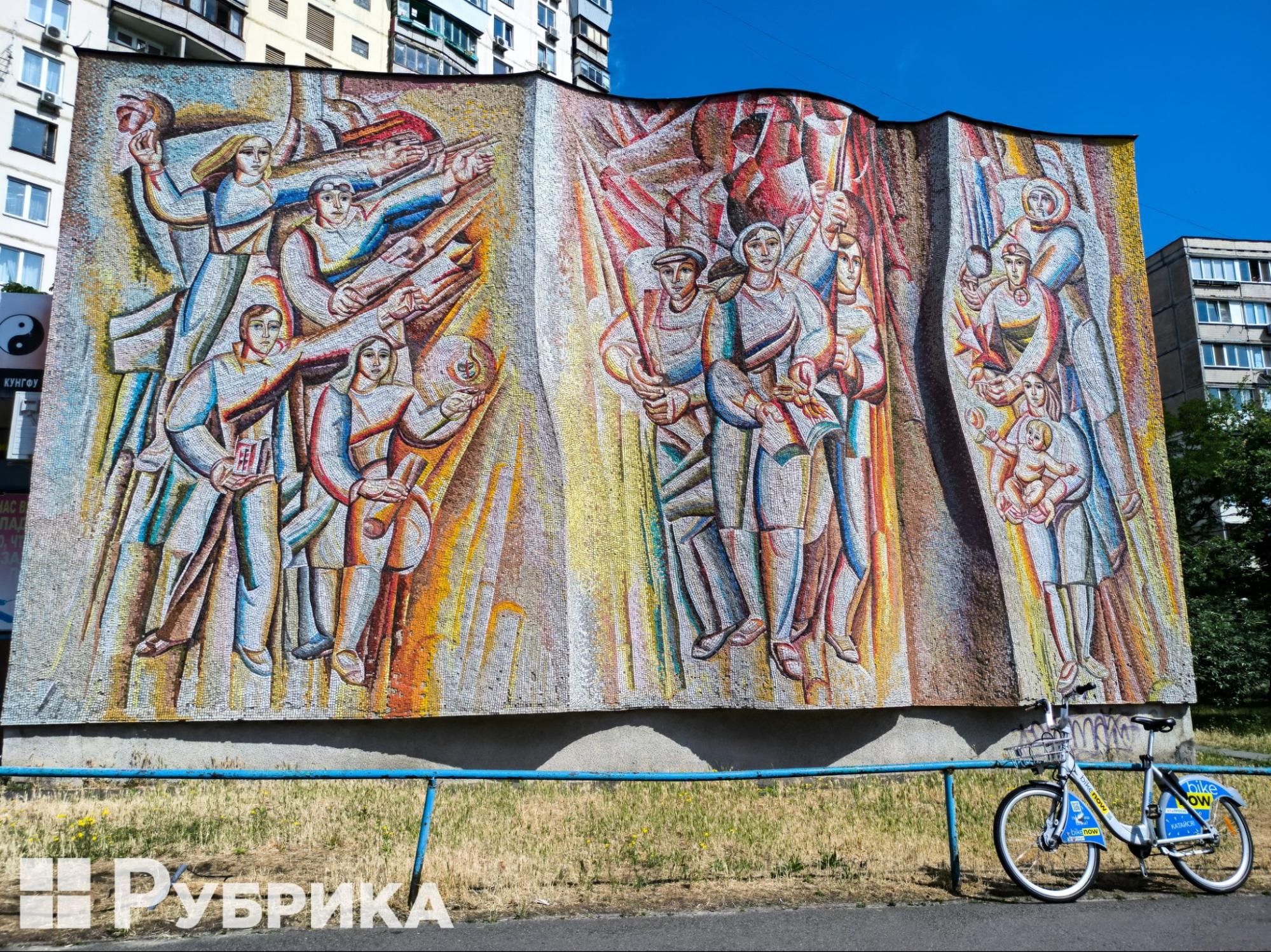
Panel at 15 Malyshka Street in Kyiv. Photo by Mykola Tymchenko
For their part, researchers and activists interested in Ukraine's cultural history have been working to preserve mosaics by documenting and educating the public about their artistic value.
Representatives of professional communities are also trying to ensure that these artifacts are officially recognized as public monuments and receive state protection — or at least to be transferred to museums if they are dismantled.
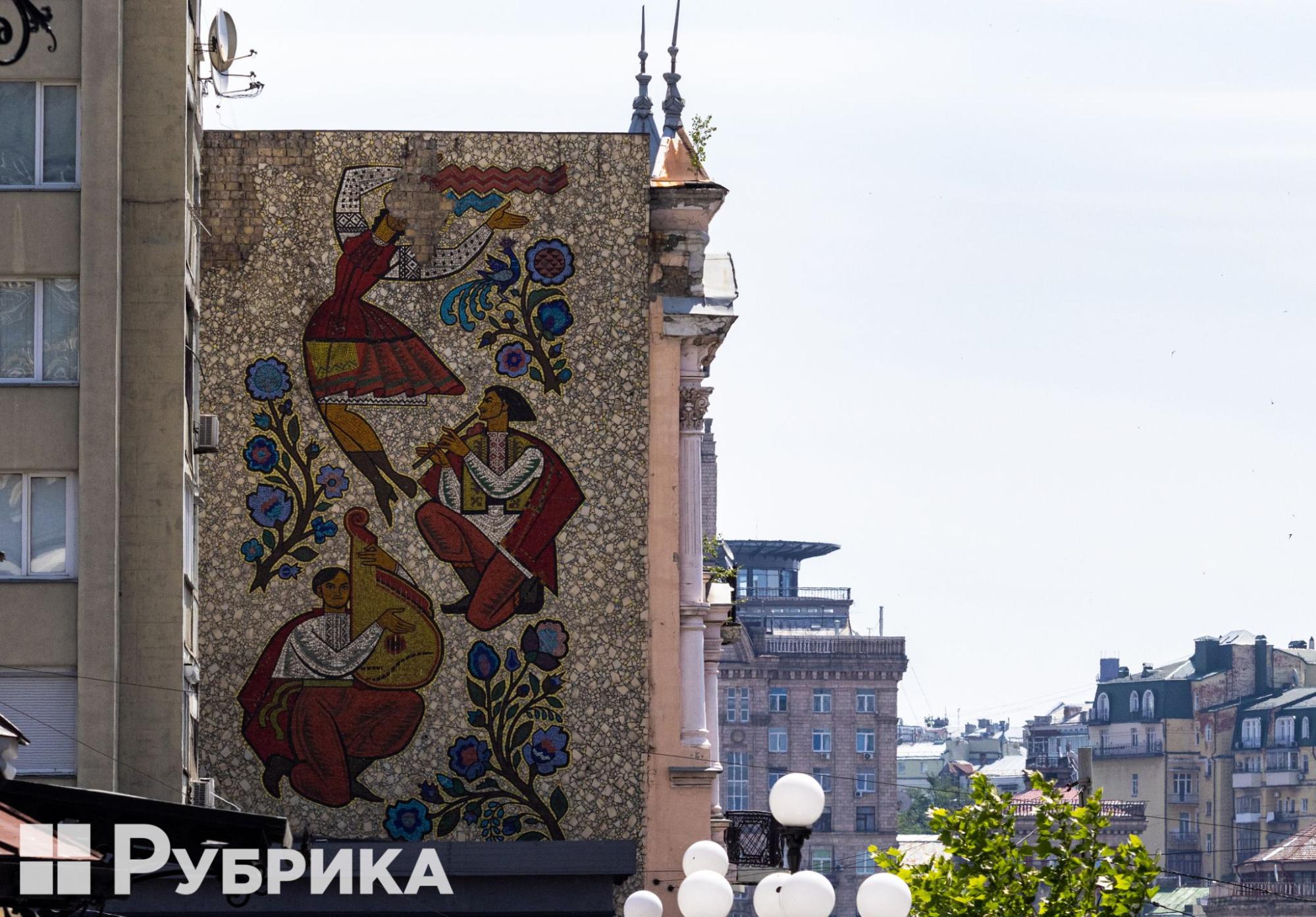
A mosaic dedicated to music and dance on the wall of a residential building facing the National Opera of Ukraine in Kyiv. Photo by Mykola Tymchenko
How does it work?
Law 7253: The fate of the mosaics will be decided by an expert commission
The new law establishes an expert commission that will provide recommendations on each specific site.Bohdan Korolenko, who works at the Ukrainian Institute of National Remembrance told Rubryka the commission will include recognized specialists from academic and higher educational institutions.
Korolenkois convinced that not all mosaics containing symbols of the totalitarian communist regime of Soviet Ukraine have yet been dismantled or removed from public space up until now. Still, it is necessary to proceed from what this mosaic panel is while deciding its fate. If the mosaic has a high artistic level and only elements of Soviet symbolism, then only these elements should be eliminated. If it is Suvorov or Kutuzov, commanders of Russian Imperial Army, or any other symbol of Russia's imperialism, then the image will be dismantled. If, for example, the image of a Russian double-headed eagle is part of the work that can be removed from the piece, then the work as a whole will be preserved.
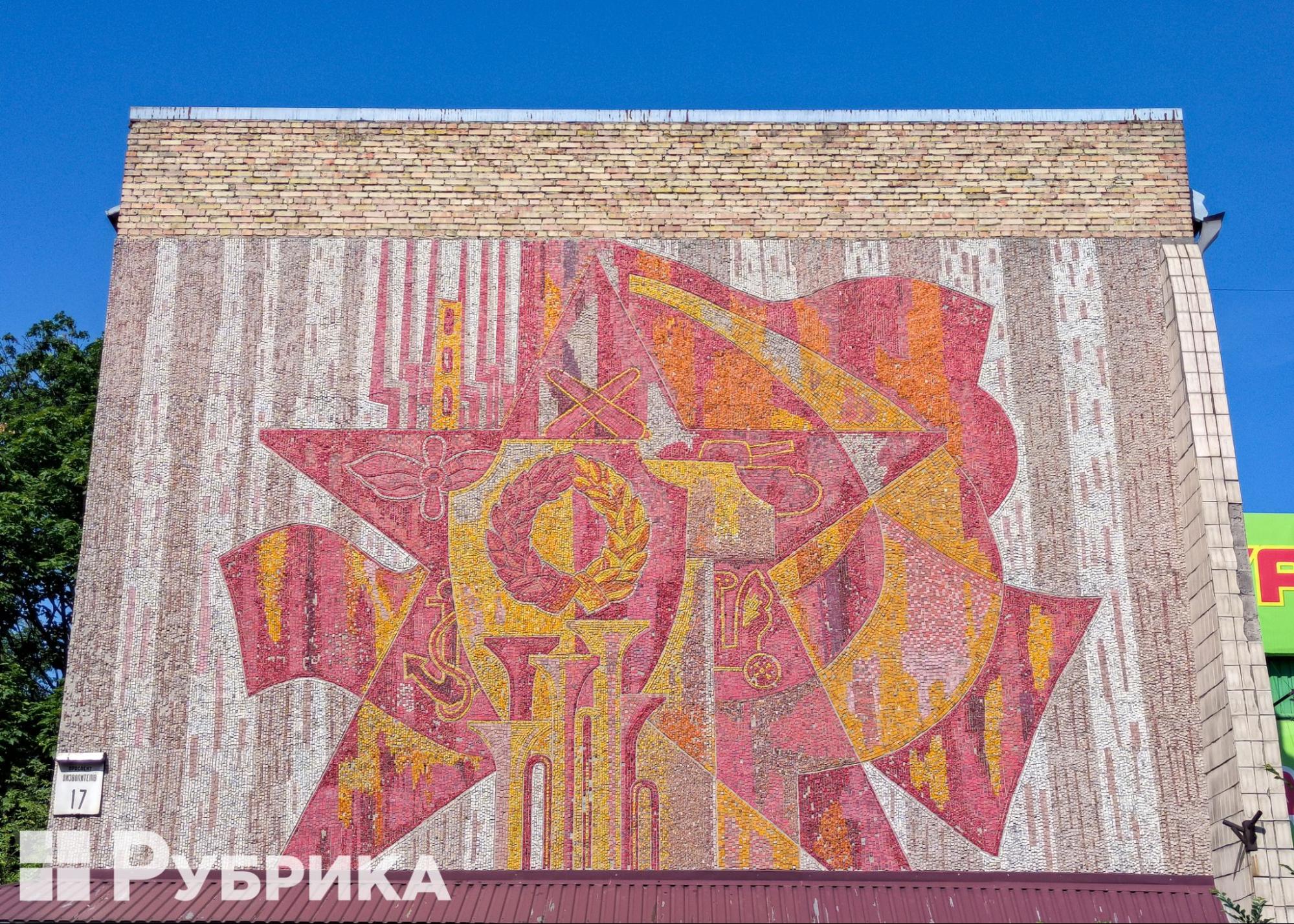
Mosaic on the Granit factory building in Kyiv. Photo by Mykola Tymchenko
Members of the public can contact Ukrainian Institute of National Remembrance, the government institution overseeing cultural preservation, when doubts arise about individual cases, and the expert commission will decide each case.
"Of course, you can't just come and knock down an object with a hammer because someone thought something was wrong. Only the Constitutional Court can interpret the current legislation, not any citizen or institution," Korolenko comments.
At the same time, he is convinced that most mosaic panels do not have high artistic value. Korolenko also reminds that most mosaic monuments are not included in the registers of cultural heritage objects.
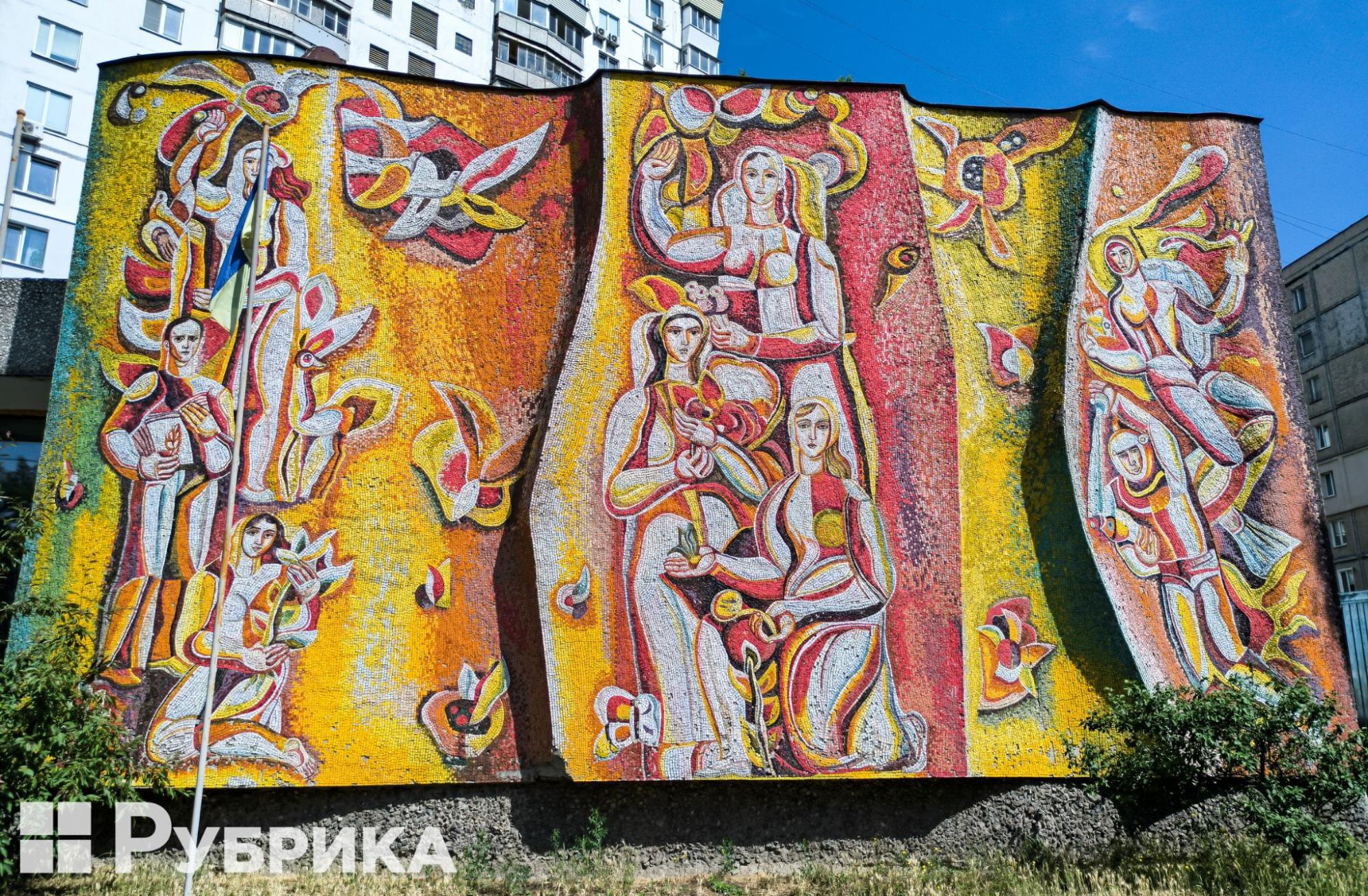
Mosaic dating back to the 1970s at 25 Malyshka Street in Kyiv shows people of different professions united by the desire for a bright future. Photo by Mykola Tymchenko.
Public activists are consequently uneasy about what will happen to monuments they wish to see preserved.
Rubryka spoke to several activists who argue that Ukraine did not just cease to exist during the time of the Soviet Union, and are working toward solutions aimed at popularizing and preserving Ukraine's cultural heritage from that period.
The online archive of Ukrainian mosaics of the Soviet period
This year marks the 10th year of the project founded by ISOLYATSIA.Platform of Cultural Initiatives in the then still free Donetsk. This is the portal of monumental and decorative art of Ukraine of the Soviet period SOVIET MOSAICS IN UKRAINE.
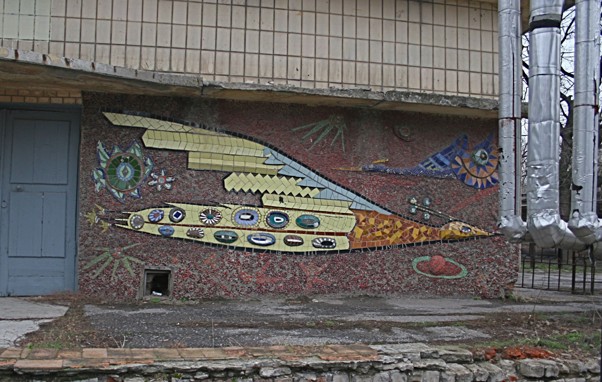
Part of the mosaic complex by Alla Horska and other artists at School No. 5 in Donetsk. Until 2013, it was the only one on the list of monuments of national importance. Photo by Olena Chervonyk.
The ISOLYATSIA Platform of Cultural began documenting Ukrainian and Soviet mosaics in 2014, with works by Alla Horska from Mariupol and Donetsk, before the cities were later occupied by Russia-backed militants. Today, the online portal Soviet Mosaics in Ukraine has grown to include works from all around the country.
The group consisted of Ukrainian artists who worked in the Soviet Union under conditions of censorship, finding ways of presenting their art despite the challenges imposed by the Soviet order.
According to Ilyenko, Ukrainian Soviet mosaics differ from Georgian, Russian, and Kyrgyz Soviet mosaics. National motives are distinguished by several motifs:
First, their distinctive bright colors.
Secondly, these are Ukrainian decorative motifs — ornaments, clothing elements, and story plots.
Thirdly, the plasticity of faces representing the Ukrainian physiognomy.
At first, photos of landmarks were posted only with an indication of the author, if it was possible to establish them, and then they began adding the date of the photos because, over time, a part of the mosaics remained only in digital form.
Ukrainian modernism
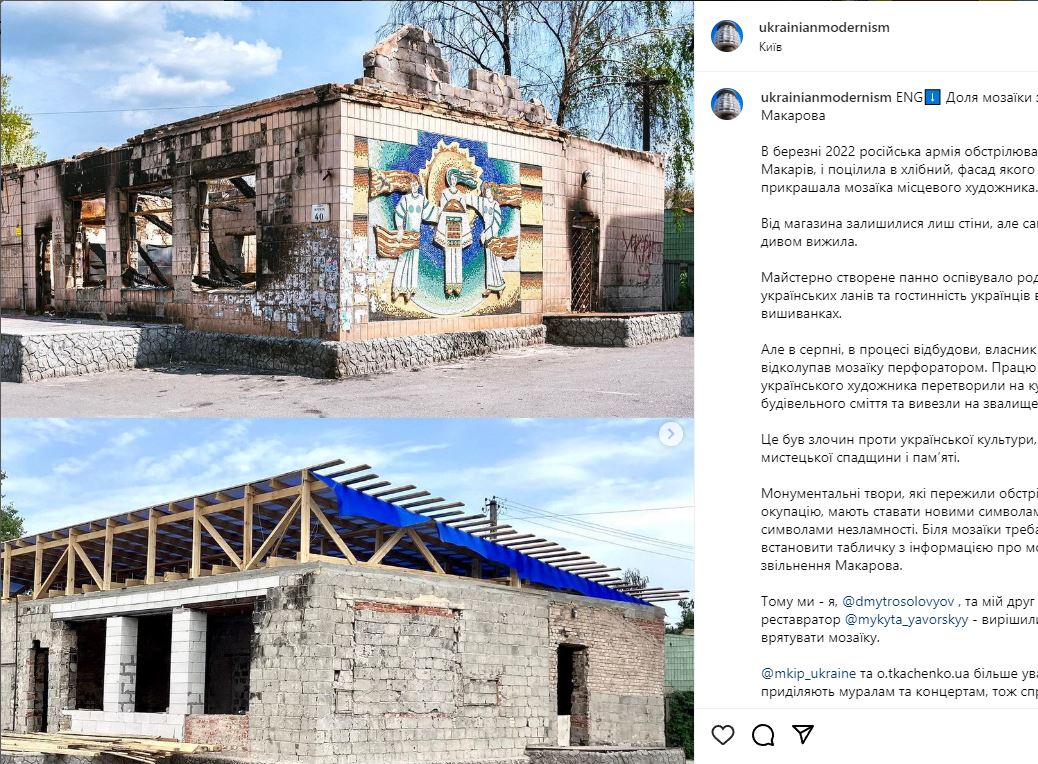
A building with a mosaic in Makariv before and after its renovation. Photo via Instagram page of the Ukrainian Modernism project.
Photographer and researcher Dmytro Solovyov created the Ukrainian Modernism project in 2018 to draw attention to Ukrainian modernist architecture of the 1960s and 1990s as an essential part of the country's cultural heritage. Often, Solovyov is the first to sound the alarm when monuments are planned to be dismantled, or is already undergoing changes. The project's Instagram page has a following of more than 95,000 architecture connoisseurs, public activists, and urban planners who advocate for the protection of this heritage — organizing public events and appealing to local authorities.

A developer destroyed the abstract mosaic sculpture of master sculptor Ernest Kotkov Dnipro Waves to build a shopping center on this site in 2019. Collage from the Facebook page of the Ukrainian Modernism project.
For example, Solovyov and his restorer friend Nikita Yavorskyi decided to save the mosaic in Makariv. In March 2022, the Russian army shelled Makariv and hit the bakery, the facade of which was decorated with a mosaic by a local artist. Only the walls remained of the store, but the mosaic itself miraculously survived. Unfortunately, in August, during the reconstruction process, the owner of the building chipped off the mosaic with power tools. The Ukrainian artist's work was turned into a pile of construction debris and taken to a landfill.
Solovyov is convinced this was a crime against Ukrainian culture, artistic heritage, and memory. In his opinion, monumental works that survived shelling and occupation should be viewed in a new light as symbols of these cities' indomitability – and it would have been better to install a new sign with information about the mosaic and Makariv's liberation instead of tearing it down.
Solovyov and Yavorskyi took the remains of the panel knocked down by the builders to Kyiv and are working to restore it.
The victory of the Chernihiv Monumentalism community
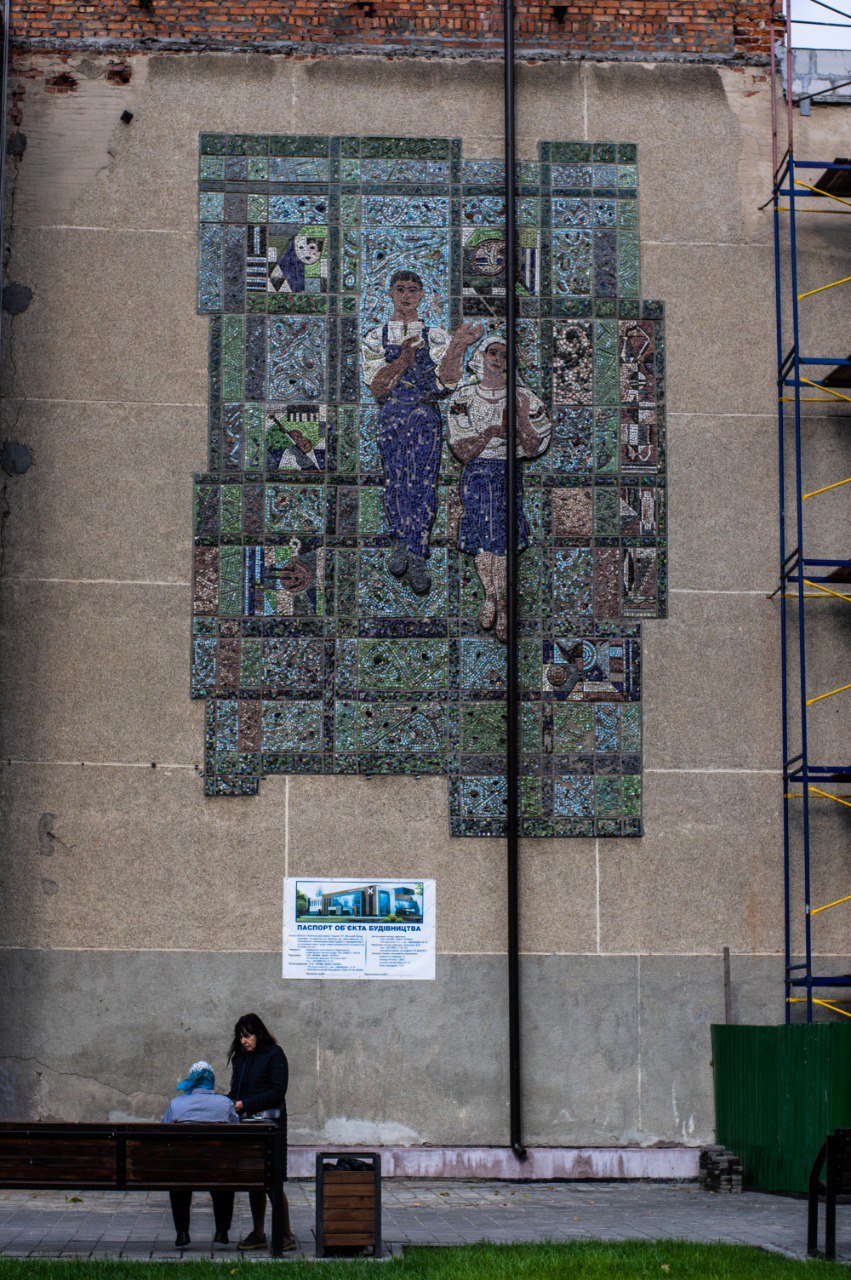
The 1970s "Workers" mosaic on the City Palace of Culture's facade was the first recorded mosaic in Chernihiv. Photo by Roman Zakrevsky, 2020.
The Chernihiv Monumentalism community emerged in 2019 as a reaction to the fact that in Chernihiv, the mosaic Motherhood by the artist Yevhen Pavlov at the maternity hospital was under threat.
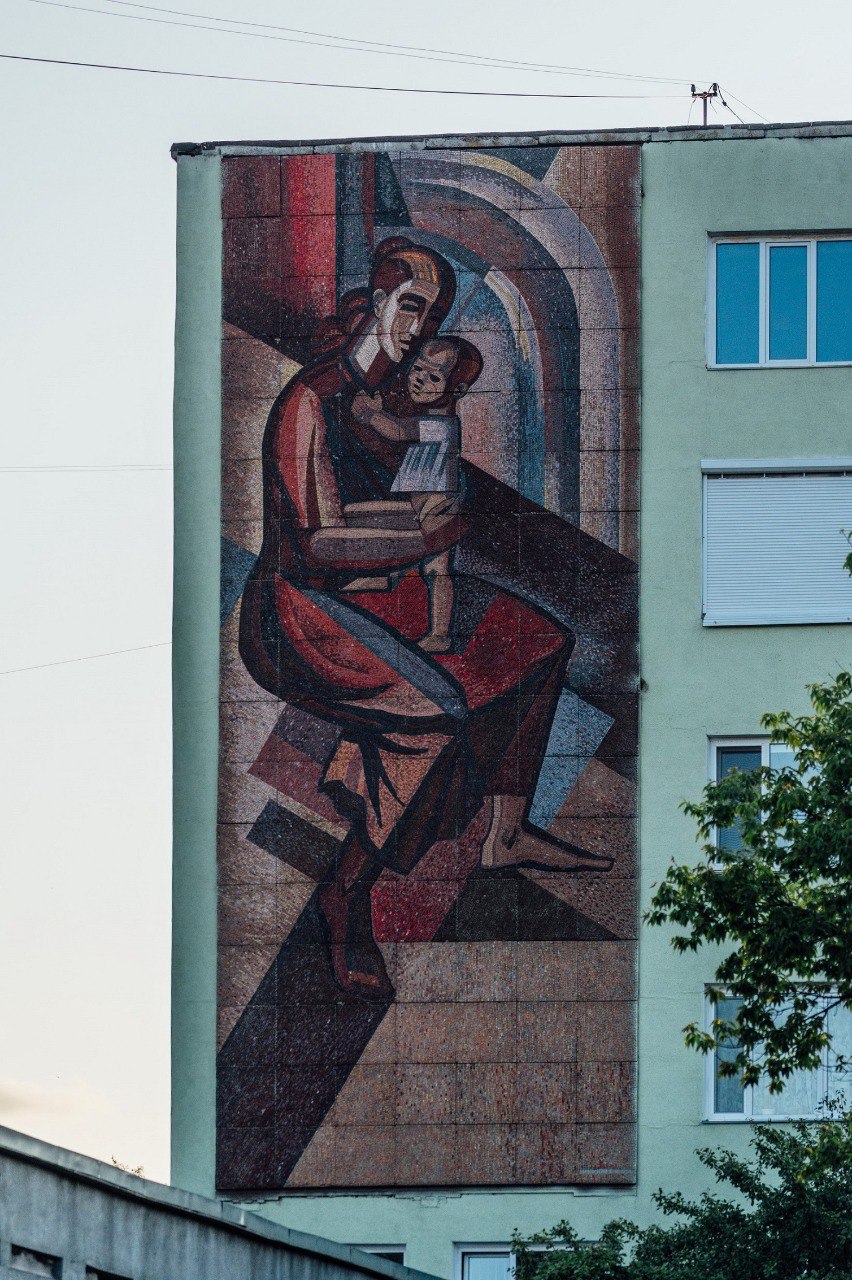
Yevhen Pavlov's "Motherhood" mosaic (1989) has been dismantled and is located in a disassembled form in the basement of the Chernihiv Art Museum. Photo by Dmytro Solovyov.
"When we already saw it dismantled, unfortunately, there were no official levers of influence, so we tried to decide its fate on behalf of the artists' union," Olena Zagrebina, the community's founder, shared with Rubryka. "The art museum director Yuriy Tkach agreed to keep this mosaic, and we continued to work on the archives. This is how our long road began." The group includes an architect, a photographer, camera operators, a local historian, and artists.
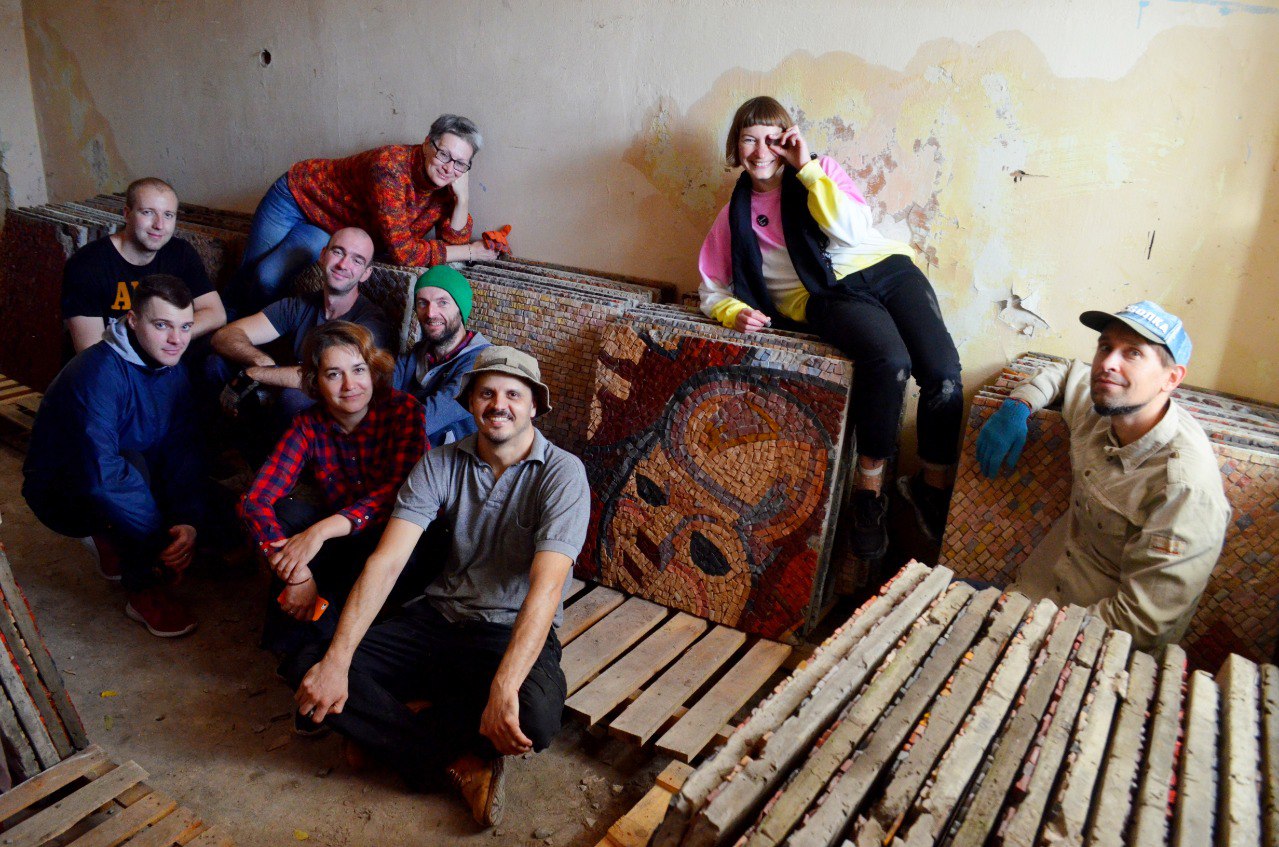
The activists moved the Motherhood mosaic in its disassembled state to the museum's basement. Photo by Roman Zakrevskyi, 2019.
Zagrebina says that their community maintains contacts with the Chernihiv Regional Department of Culture and Tourism, Nationalities and Religions, and thanks to the participation of Doctor of Historical Sciences Ihor Kondratiev in Chernihiv, there is already a precedent for the introduction of one mosaic from the 1970s — the oldest that has survived, "Workers," to the register of newly discovered monuments of the cultural heritage of monumental art.
"We already have certain documentation for most of the mosaics, and they can be submitted for protection status. However, the legislation is very complex and quite inflexible," the founder of the community states.
In 2020, community members also managed to preserve the "Ancient Chernihiv" panel by Halyna Sevruk. It was dismantled from the Hradecky Hotel and transferred to the Chernihiv Regional Art Museum, which is named after Hryhorii Galagan, to be put on display. Zagrebina recalls that the author herself, already a 91-year-old ceramist and monument artist, was able to attend the exhibition's opening at the museum.
In total, there are approximately 30 such sites in Chernihiv. Before the war, activists managed to take pictures of them. Fortunately, the city's mosaics were not damaged during that year's battles, but in general, the importance of reporting in the form of photos and videos has increased greatly during the war, the researcher emphasizes.
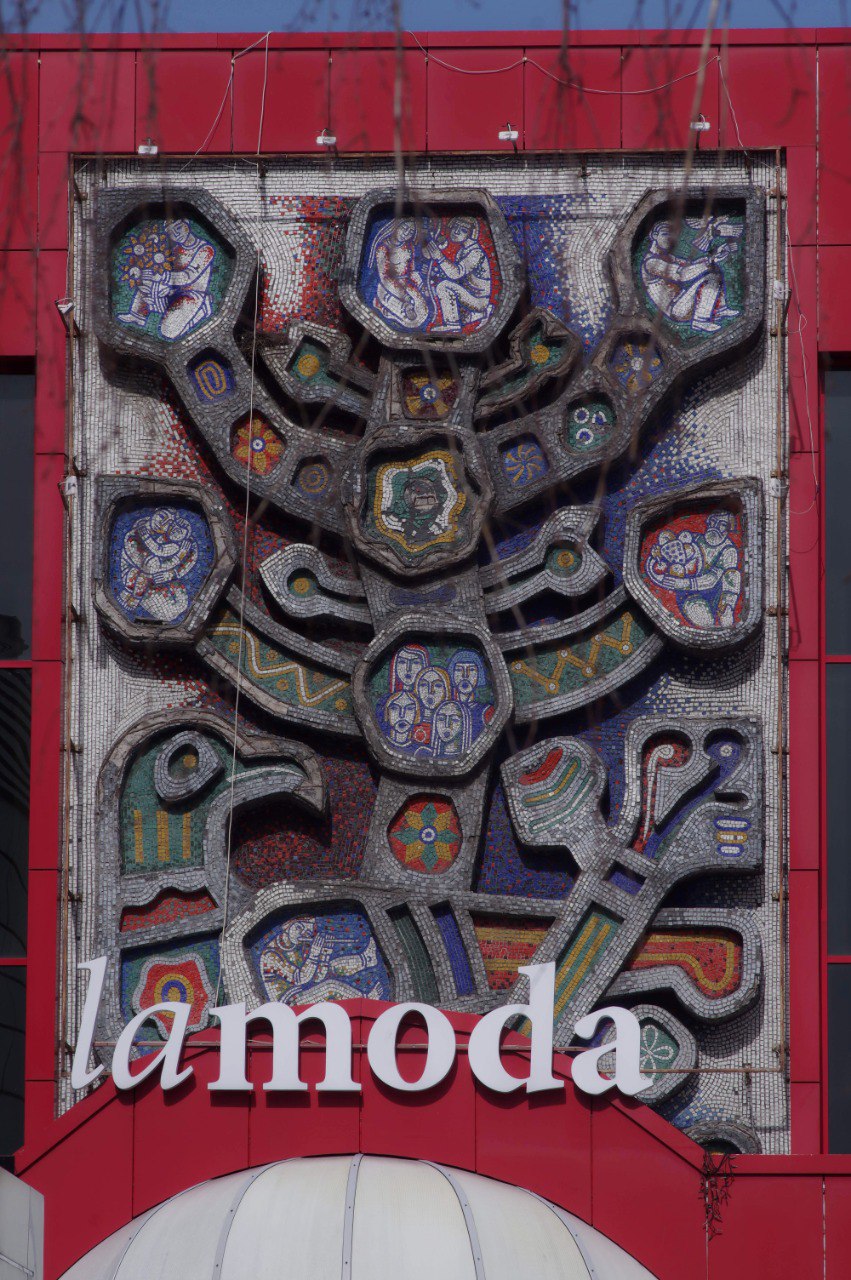
The mosaic of Ilya Tolkachov, attributed by Olena Zagrebina, was opened on April 2, 2021, as a result of negotiations with the owner of the building. Photo by Roman Zakrevskyi.
The Kintseva stop project
"Flowers, rivers, fish — are they foreign and hostile here?"
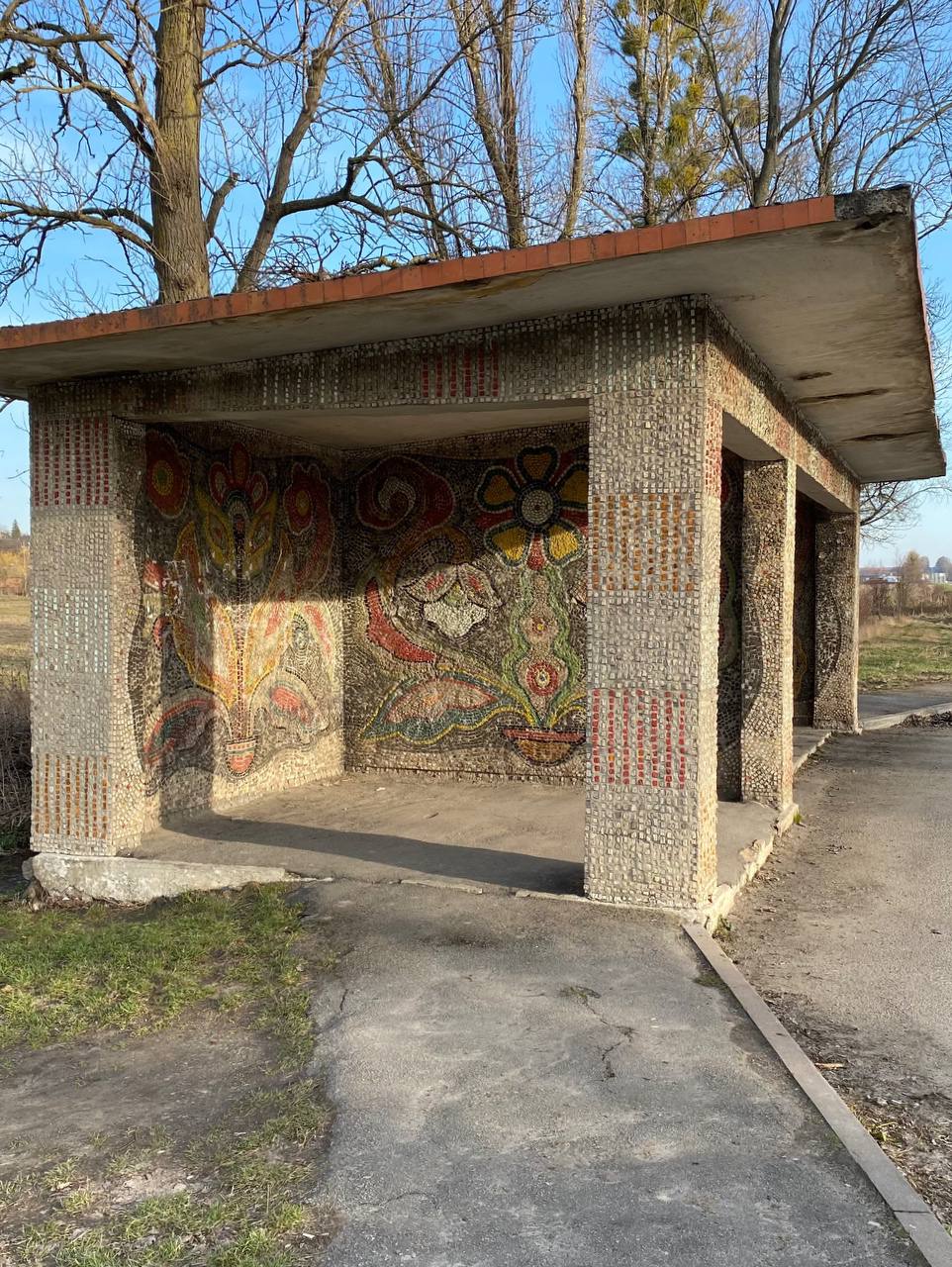
The "Giant Pavilion" is located on a highway seven kilometers from the city of Zhovkva, in the village of Smerekiv. Photo by Oleh Leviy of the Kintseva stop project.
Oleh Leviy, a student at the Ukrainian Academy of Printing, created his project less than a year ago. During this time, he cleaned up and showed on social networks up to a hundred public transport stops in the Lviv region, partly in the Ivano-Frankivsk region, Rivne region, and Bukovyna.
It started when he received an assignment to write a text about architects. Having immersed himself in the topic, Leviy became interested in Lviv modernism and the architecture of the era of the Soviet occupation of Ukraine. "I became interested in how this architecture was decorated, how people made their space more beautiful. Monumental art, mosaics, stained glass, sgraffito helped. That's how I became interested in mosaics, and already when I was riding a bicycle, I saw the stops and realized that it is worth focusing on them because few people talk about it," says Leviy.
The researcher rides a bike, takes pictures and videos of the stops, cleans them, and shares his impressions on Instagram, Telegram, and TikTok. Subscribers sometimes donate to help with washing the stops and also help with the purchase of a new rover. They also send their own photos of stops from different regions of Ukraine and even from the occupied territories –although they often ask not to name their locations.
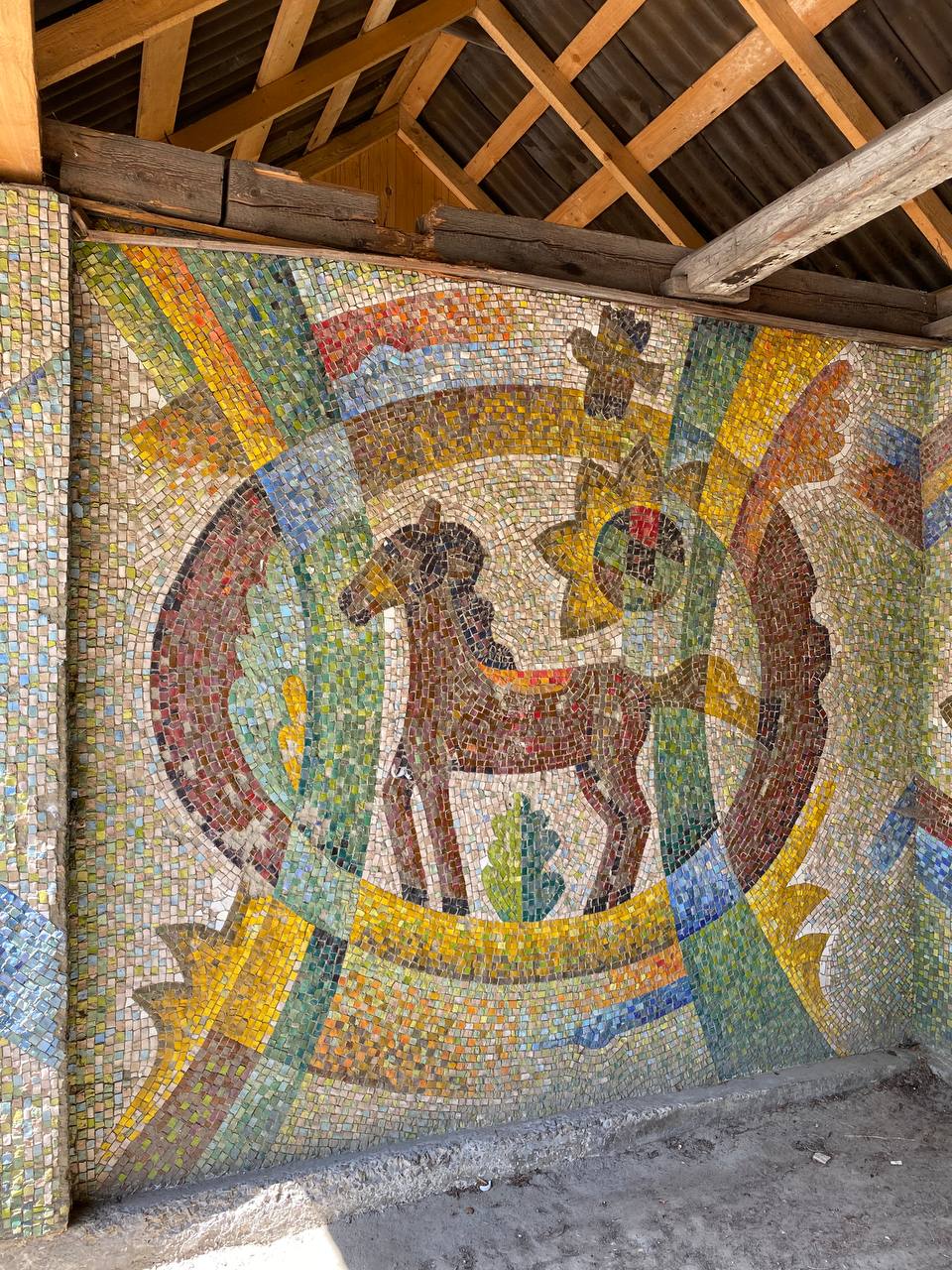
Mosaic at the bus stop in the village Tyudiv in Ivano-Frankivsk region. A replaced roof was the first step to preserving the mosaic. Photo by Oleh Leviy, Kintseva stop project.
Leviy says that sometimes residents can be suspicious of his activities,. He also says that he has written to the local authorities of asking them to pay attention to the poor condition of the pavilions, but none have responded to him yet.
"It is difficult to explain the value of this pavilion and mosaic because either they do not pay attention to it at all because they constantly live with it and it is a natural part of the environment, or it is branded as something foreign, hostile and Soviet," says Leviy. "The mosaics are all local subjects: nature, traditions and lifestyle, clothes, and occupations. Are flowers, rivers, and fish alien and hostile here? They are Ukrainian – simply with the spirit of the era when it was created."
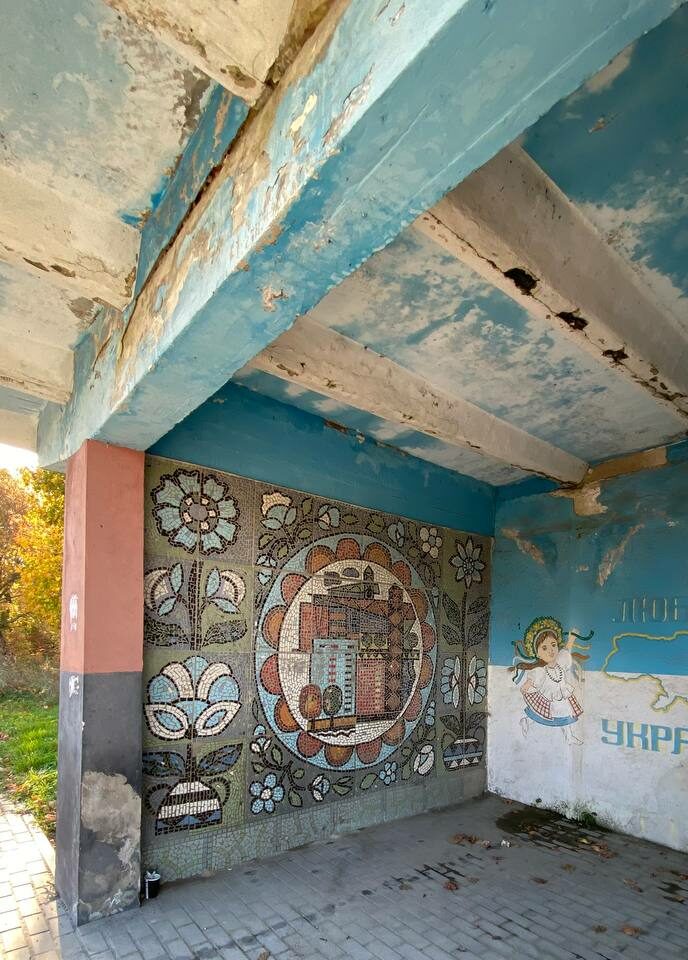
Fragments of a mosaic at a stop in the village of Hradivka, the Lviv region. Leviy writes in the description: "…you can see how the aesthetic ideas of Ukrainians of different eras are combined and answer the question: what was better, higher quality and more valuable? And what is really a manifestation of love for Ukraine?". Photo by Oleh Leviy, Kintseva stop project
Leviy's project turned to TikTok to attract a younger audience.
"I promote it because it is part of our culture. We cannot throw out this part of Ukrainian art from our history," the activist is convinced.
What should be done so that a specific mosaic is not destroyed?
Starting July 27, 2023, members of the public can apply to the expert commission of the Ukrainian Institute of National Remembrance, which will act as an arbitrator to will decide the fate of the monument.
In addition, activists Rubryka spoke to advised those interested in preserving monuments to:
- Draw as much attention to this work as possible. If there is a threat of its destruction, write about it in social networks, tagging Soviet Mosaics in Ukraine, Ukrainian Modernism. Write to other public activists you know who are interested in the topic, and contact the media.
- Report the threat of destruction to local departments or cultural administrations and monument protection institutions.
- Distribute information about mosaics' value on all available platforms, attracting expert opinions. In this way, you will be able to increase the number of supporters of the mosaic and those who will be able to join you in its protection.
- Contact artists, researchers, and other specialists who can help with filling out an application for granting the mosaic the status of a monument of local or national significance.
"Submitting an application is the most effective – yet quite complex – process, which requires a certain level of preparation," says Molyar.
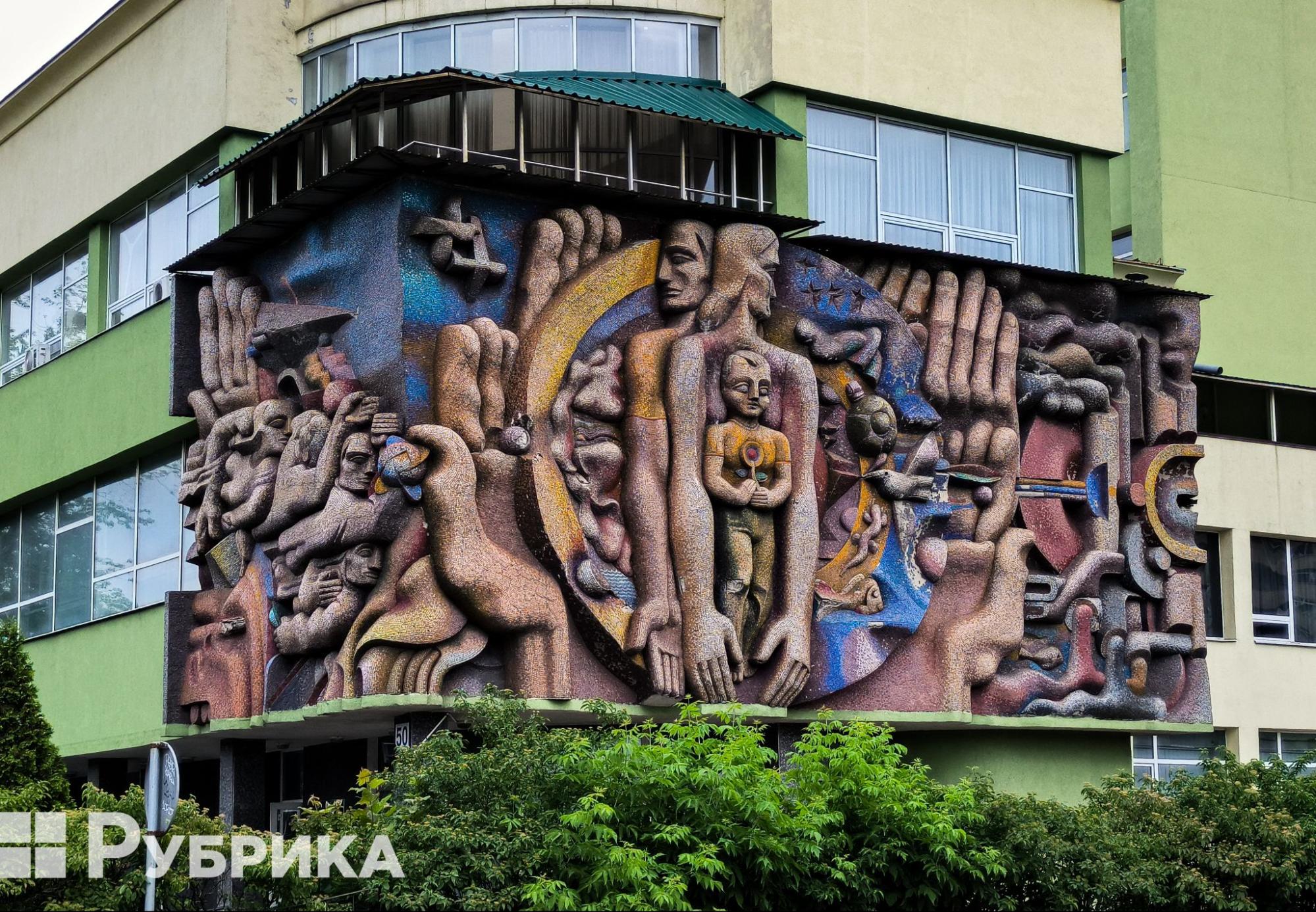
A panel on a building near the Chernihivska metro station in Kyiv. Photo by Mykola Tymchenko.
Other solutions
- In 2019, after the scandal involving the destruction of the Sea and Fish mosaic (later restored the following year), the Lviv City Council approved the list of historical mosaic works of Lviv and, in early 2023, presented an online map of the most valuable of them. The owners of the buildings or sites where the mosaics are placed cannot dismantle them, only repair them.
- Retrotopia, an exhibition of socialist design works by authors from 11 countries, including Ukraine, is currently open in Berlin. The event's theme is the history of design in the countries of the former Eastern Bloc and Yugoslavia between the 1950s and 1980s. In the Ukrainian section of the exhibition, monumental and decorative works such as mosaics are presented.
- Fashion editor and cultural expert Victoria Zubenko turned her hobby of photographing bus stop complexes with mosaics into the brand BERVY — silk scarves with prints of fragments of these murals. Recently, she recreated Alla Horska's mosaics that were destroyed in Mariupol on handkerchiefs.
- In 2020, Mariupol art critic Oleksandr Chernov and journalist Stanislav Ivanov published the book "All Shades of Mariupol Mosaics," where they recorded information about 26 mosaics that could still be seen on the walls of the city's buildings at that time. Now Ivanov is reprinting the book – mainly as a memory of those sights. In 2022, he published the photo guide Mariupol Monumental, also dedicated to the heritage of Mariupol monumentalist artists which are now mostly lost to the Russian invaders who today occupy the eastern Ukrainian city.
Newsletter
Digest of the most interesting news: just about the main thing









Add comment